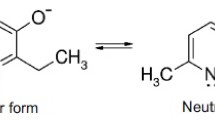Abstract
Cadmium (Cd) inhibited the activities of Na+-K+ ATPase (IC50=5.0×10−5 M), K+-p-nitrophenyl phosphatase (PNPPase) (IC50=4.0×10−5 M) and 3H-ouabain binding (IC50=7.5×10−5 M) in rat brain microsomes. Monothiols (cysteine but not glutathione and D-pencillamine) and dithiols (dimercaprol, dimercaptosuccinic acid and dithiothreitol) offered varied levels of protection against Cd-inhibition of Na+-K+ ATPase. Protection of Na+-K+ ATPase by these sulfhydryl (SH) agents was higher at 7.5 as compared to 8.5 pH. The present data suggest that Cd-inhibited Na+-K+ ATPase, by interfering with phosphorylation of enzyme molecule and dephosphorylation of the enzyme-phosphoryl complex and exerts a similar effect to that of SH-blocking agents.
Similar content being viewed by others
References
Albers RW, Koval GJ (1972) Sodium-potassium-activated adenosine triphosphatase. VII Concurrent inhibition of adenosine triphosphatase and activation of K+-nitrophenyl phosphatase activity. J Biol Chem 247:3088–3092
Albers RW, Koval GJ, Siegel GJ (1978) Studies on the interaction of ouabain and other cardiac active steroids with sodium-potassium-activated adenosine triphosphatase. Molec Pharmacol 4:324–336
Aposhian HV (1958) Protection by D-pencillamine against the lethal effects of mercuric chloride. Science 128:93
Baba A, Kihara T, Lee E, Iwata H (1981) Activation of rat brain adenylate cyclase by copper plus dithiothreitol. Biochem Pharmacol 30:171–174
Braun HA, Lusky LM, Calvery HO (1946) The efficacy of 2,3-dimercaptopropanol (BAL) in the therapy of poisoning by compounds of antimony, bismuth, chromium, mercury and nickel. J Pharmacol Exp Ther 87 (Suppl):119–125
Cantilena RC Jr, Klassen CD (1981) Decreased effectiveness of chelation therapy with time after acute cadmium poisoning. Toxicol Appl Pharmacol 63:173–180
Chetty CS, Rajanna B, Rajanna S (1990) Inhibition of rat brain microsomal Na+-K+ ATPase and ouabain binding by mercuric chloride. Toxicol Lett 51:109–116
Cleland L (1964) Dithiothreitol, a new protective reagent for SH groups. Biochemistry 3(4):480–482
Cooper GP, Suszkiw JB, Manalis RS (1984) Presynaptic effects of heavy metals. In: Narahashi T (ed) Cellular and molecular neurotoxicity. Raven Press, NY, pp 1–21
Gabard B (1976) Treatment of methylmercury poisoning in the rat with sodium 2,3-dimercaptopropane-1-sulfonate: Influence of dose and mode of administration. Toxicol Appl Pharmacol 38:415–424
Kabeer IA, Rajender RJ, Desaiah D (1989) Protection against cadmium toxicity and enzyme inhibition by dithiothreitol. Cell Biochem Function 7:185–192.
Koch RB (1969) Fractionation of olfactory tissue homogenates: Isolation of a concentrated plasma membrane fraction. J Neurochem 16:145–157
Lai JCK, Guest JF, Leung TKC, Lim L, Davison AW (1980) The effects of cadmium, manganese and aluminium on sodium, potassium-activated and magnesium-activated adenosine triphosphatase activity and choline uptake in rat brain synaptosomes. Biochem Pharmacol 29:141–146
Lowry OH, Lopez JM (1946) The determination of inorganic phosphate in the presence of labile phosphate esters. J Biol Chem 162:421–428
Lowry OH, Rosebrough NJ, Farr AL, Randall RJ (1951) Protein measurement with folin phenol reagent. J Biol Chem 193:265–275
Phillips TD, Hayes AW (1977) Effects of ptaulin on adenosine triphosphatase activity in the mouse. Toxicol Appl Pharmacol 42:175–187
Rajanna B, Chapatwala KD, Vaishnav DD, Desaiah D (1981) Changes in ATPase activity in tissues of rats fed on cadmium. J Environ Biol 2:1–9
Rajanna B, Chetty CS, Rajanna S (1990) Effect of mercuric chloride on the kinetics of cationic and substrate activation of rat brain microsomal ATPase system. Biochem Pharmacol 39(12):1935–1940
Schwartz A, Lindenmayer GE, Allen JC (1971) The Na+-K+ ATPase membrane transport system: Importance in cellular function. In: Banner F, Kleinzeller A (eds) Current topics on membranes and transport. Academic Press, NY, p 1
Skou JC, Hilberg CH (1965) The effect of sulfhydryl-blocking reagents and of urea on the (Na+-K+) activated enzyme system. Biochim Biophys Acta 110:359–369
Suzuki S, Ozaki N (1984) The protective effects of thiol-containing compounds on mercuric chloride-induced acute inhibition of enzymes from mouse kidney. Toxicology 29:207–220
Vallee BL, Ulmer DD (1972) Biochemical effects of mercury, cadmium and lead. Ann Rev Biochem 41:91–128
Webster WS, Valois AA (1981) The toxic effect of cadmium on the neonatal mouse CNS. J Neuropathol Exp Neurol 40:247–257
Author information
Authors and Affiliations
Rights and permissions
About this article
Cite this article
Chetty, C.S., Cooper, A., McNeil, C. et al. The effects of cadmium in vitro on adenosine triphosphatase system and protection by thiol reagents in rat brain microsomes. Arch. Environ. Contam. Toxicol. 22, 456–458 (1992). https://doi.org/10.1007/BF00212567
Received:
Revised:
Issue Date:
DOI: https://doi.org/10.1007/BF00212567



